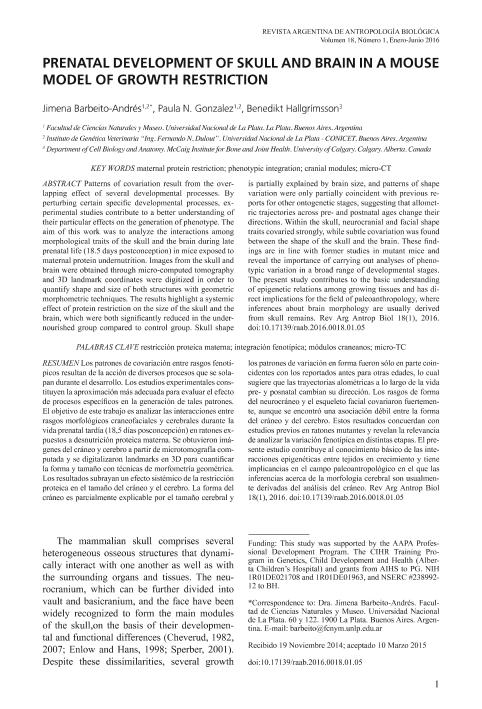Mostrar el registro sencillo del ítem
dc.contributor.author
Barbeito Andrés, Jimena

dc.contributor.author
Gonzalez, Paula Natalia

dc.contributor.author
Hallgrimsson, Benedikt

dc.date.available
2018-06-13T14:03:55Z
dc.date.issued
2016-01
dc.identifier.citation
Barbeito Andrés, Jimena; Gonzalez, Paula Natalia; Hallgrimsson, Benedikt; Prenatal development of skull and brain in a mouse model of growth restriction; Asociación de Antropología Biológica Argentina; Revista Argentina de Antropología Biológica; 18; 1; 1-2016
dc.identifier.issn
1514-7991
dc.identifier.uri
http://hdl.handle.net/11336/48493
dc.description.abstract
Patterns of covariation result from the over-lapping effect of several developmental processes. By perturbing certain specific developmental processes, ex-perimental studies contribute to a better understanding of their particular effects on the generation of phenotype. The aim of this work was to analyze the interactions among morphological traits of the skull and the brain during late prenatal life (18.5 days postconception) in mice exposed to maternal protein undernutrition. Images from the skull and brain were obtained through micro-computed tomography and 3D landmark coordinates were digitized in order to quantify shape and size of both structures with geometric morphometric techniques. The results highlight a systemic effect of protein restriction on the size of the skull and the brain, which were both significantly reduced in the under-nourished group compared to control group. Skull shape is partially explained by brain size, and patterns of shape variation were only partially coincident with previous re-ports for other ontogenetic stages, suggesting that allomet-ric trajectories across pre- and postnatal ages change their directions. Within the skull, neurocranial and facial shape traits covaried strongly, while subtle covariation was found between the shape of the skull and the brain. These find-ings are in line with former studies in mutant mice and reveal the importance of carrying out analyses of pheno-typic variation in a broad range of developmental stages. The present study contributes to the basic understanding of epigenetic relations among growing tissues and has di-rect implications for the field of paleoanthropology, where inferences about brain morphology are usually derived from skull remains.
dc.description.abstract
Los patrones de covariación entre rasgos fenotí-picos resultan de la acción de diversos procesos que se sola-pan durante el desarrollo. Los estudios experimentales cons-tituyen la aproximación más adecuada para evaluar el efecto de procesos específicos en la generación de tales patrones. El objetivo de este trabajo es analizar las interacciones entre rasgos morfológicos craneofaciales y cerebrales durante la vida prenatal tardía (18,5 días posconcepción) en ratones ex-puestos a desnutrición proteica materna. Se obtuvieron imá-genes del cráneo y cerebro a partir de microtomografía com-putada y se digitalizaron landmarks en 3D para cuantificar la forma y tamaño con técnicas de morfometría geométrica. Los resultados subrayan un efecto sistémico de la restricción proteica en el tamaño del cráneo y el cerebro. La forma del cráneo es parcialmente explicable por el tamaño cerebral y los patrones de variación en forma fueron sólo en parte coin-cidentes con los reportados antes para otras edades, lo cual sugiere que las trayectorias alométricas a lo largo de la vida pre- y posnatal cambian su dirección. Los rasgos de forma del neurocráneo y el esqueleto facial covariaron fuertemen-te, aunque se encontró una asociación débil entre la forma del cráneo y del cerebro. Estos resultados concuerdan con estudios previos en ratones mutantes y revelan la relevancia de analizar la variación fenotípica en distintas etapas. El pre-sente estudio contribuye al conocimiento básico de las inte-racciones epigenéticas entre tejidos en crecimiento y tiene implicancias en el campo paleoantropológico en el que las inferencias acerca de la morfología cerebral son usualmen-te derivadas del análisis del cráneo.
dc.format
application/pdf
dc.language.iso
eng
dc.publisher
Asociación de Antropología Biológica Argentina
dc.rights
info:eu-repo/semantics/openAccess
dc.rights.uri
https://creativecommons.org/licenses/by-nc-sa/2.5/ar/
dc.subject
Maternal Protein Restriction
dc.subject
Phenotypic Integration
dc.subject
Cranial Modules
dc.subject
Micro Ct
dc.subject.classification
Otras Ciencias Biológicas

dc.subject.classification
Ciencias Biológicas

dc.subject.classification
CIENCIAS NATURALES Y EXACTAS

dc.title
Prenatal development of skull and brain in a mouse model of growth restriction
dc.type
info:eu-repo/semantics/article
dc.type
info:ar-repo/semantics/artículo
dc.type
info:eu-repo/semantics/publishedVersion
dc.date.updated
2018-06-12T13:31:48Z
dc.journal.volume
18
dc.journal.number
1
dc.journal.pais
Argentina

dc.journal.ciudad
La Plata
dc.description.fil
Fil: Barbeito Andrés, Jimena. Consejo Nacional de Investigaciones Científicas y Técnicas. Centro Científico Tecnológico CONICET- La Plata. Instituto de Genética Veterinaria "Ing. Fernando Noel Dulout". Universidad Nacional de La Plata. Facultad de Ciencias Veterinarias. Instituto de Genética Veterinaria; Argentina. Universidad Nacional de La Plata. Facultad de Ciencias Naturales y Museo; Argentina
dc.description.fil
Fil: Gonzalez, Paula Natalia. Consejo Nacional de Investigaciones Científicas y Técnicas. Centro Científico Tecnológico CONICET- La Plata. Instituto de Genética Veterinaria "Ing. Fernando Noel Dulout". Universidad Nacional de La Plata. Facultad de Ciencias Veterinarias. Instituto de Genética Veterinaria; Argentina. Universidad Nacional de La Plata. Facultad de Ciencias Naturales y Museo; Argentina
dc.description.fil
Fil: Hallgrimsson, Benedikt. University of Calgary; Canadá
dc.journal.title
Revista Argentina de Antropología Biológica
dc.relation.alternativeid
info:eu-repo/semantics/altIdentifier/url/http://www.revistas.unlp.edu.ar/raab/article/view/2225
dc.relation.alternativeid
info:eu-repo/semantics/altIdentifier/doi/http://dx.doi.org/10.17139/raab.2016.0018.01.05
Archivos asociados
